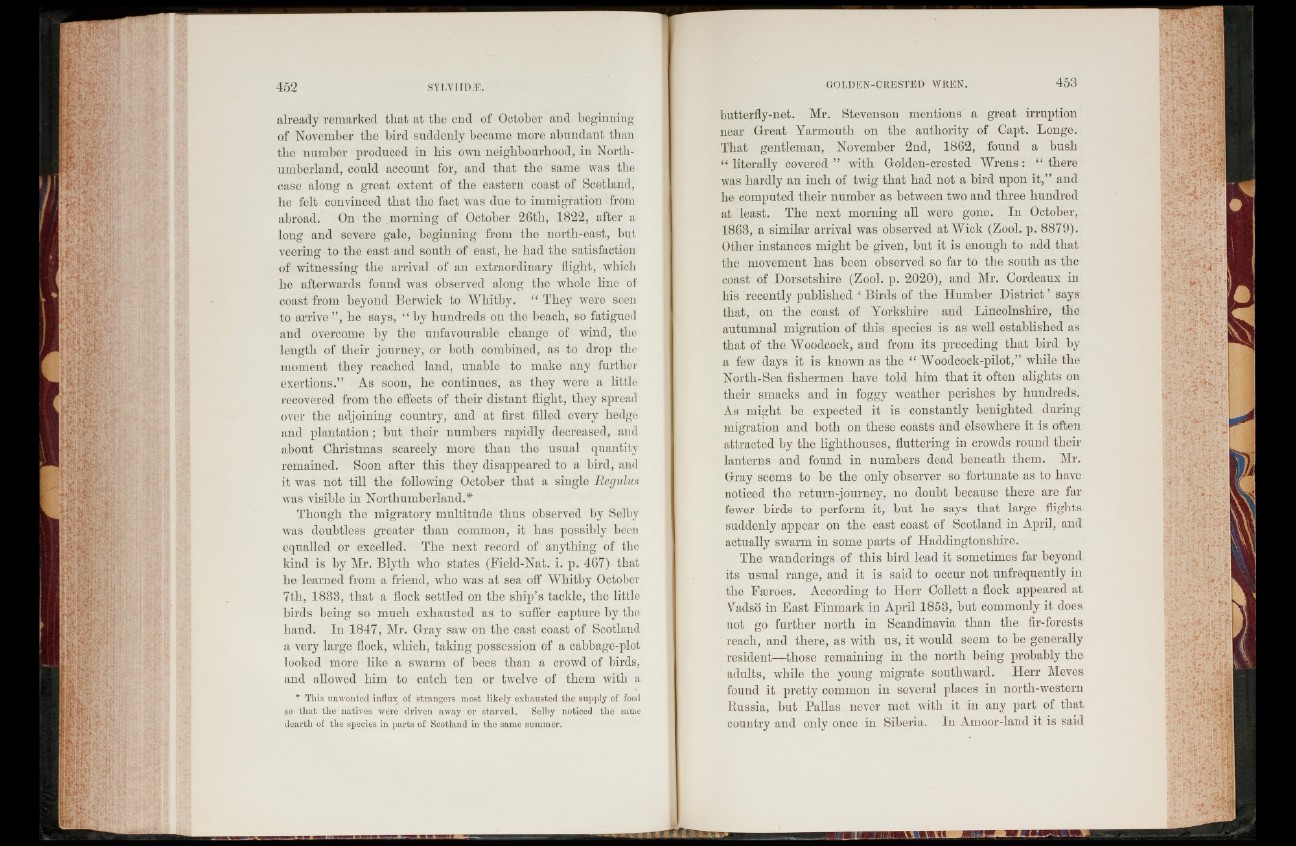
already remarked that at the end of October and beginning
of November the bird suddenly became more abundant than
the number produced in bis own neighbourhood, in Northumberland,
could account for, and that the same was the
case along a great extent of the eastern coast of Scotland,
be felt convinced that the fact was due to immigration from
abroad. On the .morning of October 26th, 1822, after a
long and severe gale, beginning from the north-east, but
veering to the east and south of east, be bad the satisfaction
of witnessing the arrival of an extraordinary flight, which
he afterwards found was observed along the whole line of
coast from beyond Berwick to Whitby. “ They were seen
to arrive”, he says, “ by hundreds 011 the beach, so fatigued
and overcome by the unfavourable change of wind, the
length of their journey, or both combined, as to drop the
moment they reached land, unable to make any further
exertions.” As soon, he continues, as they were a little
recovered from the effects of their distant flight, they spread
over the adjoining country, and at first filled every hedge
and plantation; but their numbers rapidly decreased, and
about Christmas scarcely more than the usual quantity
remained. Soon after this they disappeared to a bird, and
it was not till the following October that a single Regulus
was visible in Northumberland.*
Though the migratory multitude thus observed by Selby
was doubtless greater than common, it has possibly been
equalled or excelled. The next record of anything of the
kind is by Mr. Blyth who states (Field-Nat. i. p. 467) that
he learned from a friend, who was at sea off Whitby October
7th, 1833, that a flock settled on the ship’s tackle, the little
birds being so much exhausted as to suffer capture by the
hand. In 1847, Mr. Gray saw on the east coast of Scotland
a very large flock, which, taking possession of a cabbage-plot
looked more like a swarm of bees than a crowd of birds,
and allowed him to catch ten 01* twelve of them with a
* This unwonted influx o£ strangers most likely exhausted the supply of food
so that the natives were driven away or starved. Selby noticed the same
dearth of the species in parts of Scotland in the same summer.
butterfly-net. Mr. Stevenson mentions a great irruption
near Great Yarmouth on the authority of Capt. Longe.
That gentleman, November 2nd, 1862, found a bush
“ literally covered ” with Golden-crested Wrens : “ there
was hardly an inch of twig that had not a bird upon it,” and
he computed their number as between two and three hundred
at least. The next morning all were gone. In October,
1863, a similar arrival was observed at Wick (Zool. p. 8879).
Other instances might be given, hut it is enough to add that
the movement has been observed so far to the south as the
coast of Dorsetshire (Zool. p. 2020), and Mr. Cordeaux in
his recently published ‘ Birds of the Humber District ’ says
that, on the coast of Yorkshire and Lincolnshire, the
autumnal migration of this species is as well established as
that of the Woodcock, and from its preceding that bird by
a few days it is known as the “ Woodcock-pilot,” while the
Nortli-Sea fishermen have told him that it often alights on
their smacks and in foggy weather perishes by hundreds.
As might be expected it is constantly benighted during
migration and both on these coasts and elsewhere it is often
attracted by the lighthouses, fluttering in crowds round their
lanterns and found in numbers dead beneath them. Mr.
Gray seems to be the only observer so fortunate as to have
noticed the return-journey, no doubt because there are far
fewer birds to perform it, but he says that large flights
suddenly appear on the east coast of Scotland in April, and
actually swarm in some parts of Haddingtonshire.
The wanderings of this bird lead it sometimes far beyond
its usual range, and it is said to occur not unfrequently in
the Faeroes. According to Herr Collett a flock appeared at
Vadso in East Finmark in April 1853, but commonly it does
not go further north in Scandinavia than the fir-forests
reach, and there, as with us, it would seem to he generally
resident—those remaining in the north being probably the
adults, while the young migrate southward. Herr Meves
found it pretty common in several places in north-western
Russia, but Pallas never met with it in any part of that
country and only once in Siberia. I 11 Amoor-land it is said